Leadership Styles, Organizational Structure, and Legal Requirements
VerifiedAdded on 2023/06/10
|10
|2562
|79
Report
AI Summary
This report delves into the multifaceted aspects of managing people within organizations, focusing on leadership styles, organizational structure, and legal requirements. It begins by comparing various leadership styles, including authoritarian, participative, delegation, transactional, and transformational approaches, highlighting their uses and implications within an organizational context. The report then explores different organizational structures, such as horizontal, divisional, matrix, and hierarchical, and analyzes the relationship between organizational structure and culture. Furthermore, it examines the legal requirements regarding equal opportunity and the benefits of diversity in the workplace, emphasizing the importance of compliance with relevant acts like the Equality Act. The report uses Tesco as a case study to illustrate the practical application of these concepts, providing a comprehensive overview of managing people in organizations.
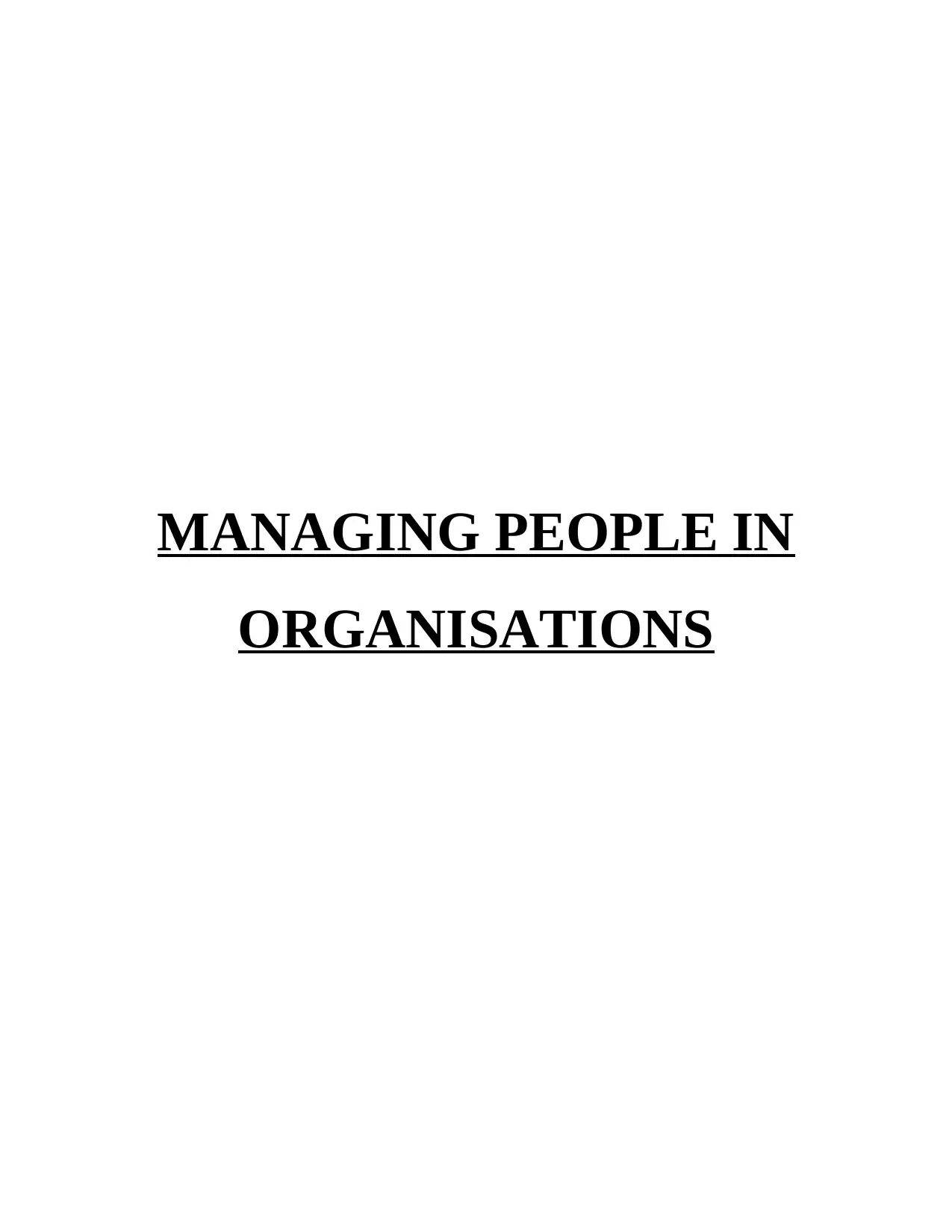
MANAGING PEOPLE IN
ORGANISATIONS
ORGANISATIONS
Paraphrase This Document
Need a fresh take? Get an instant paraphrase of this document with our AI Paraphraser
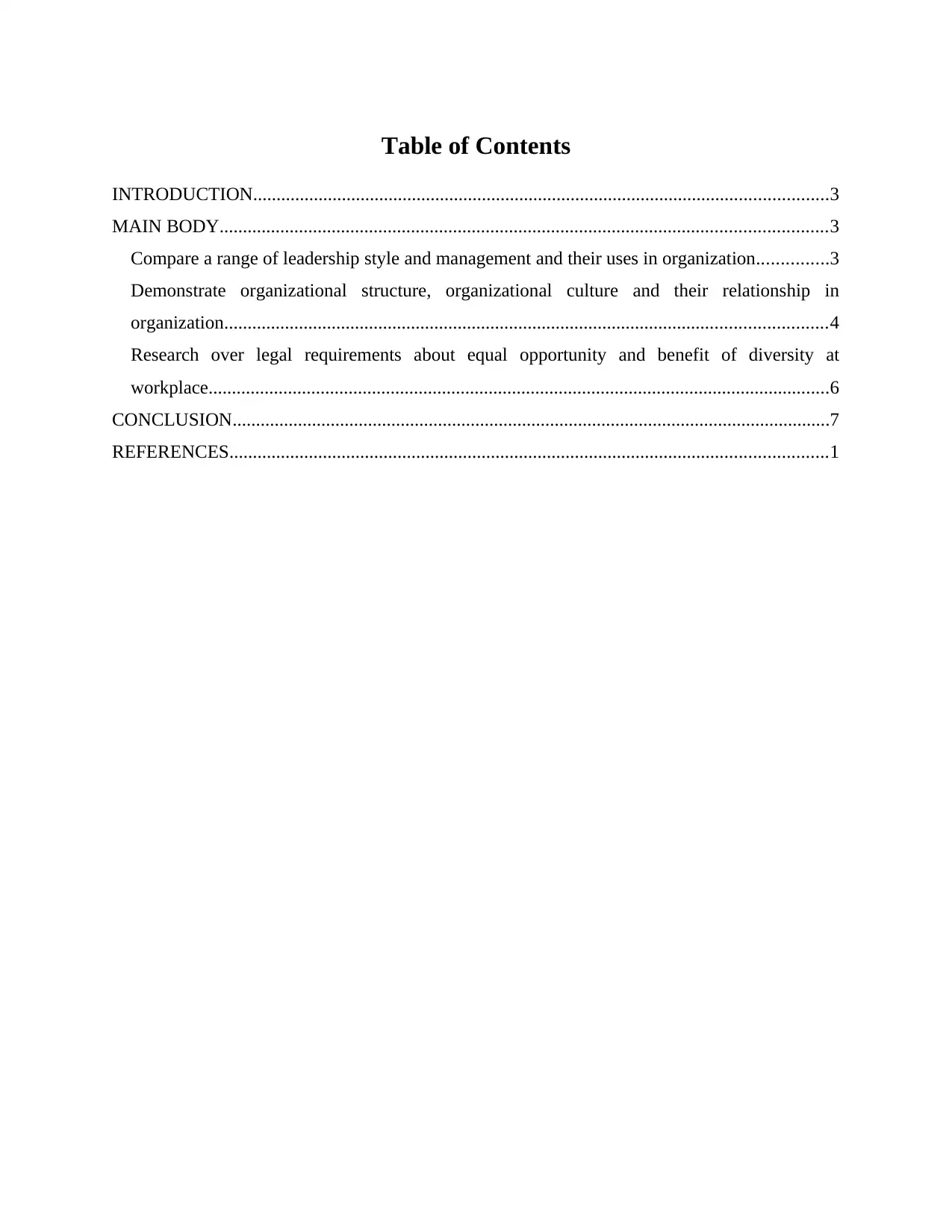
Table of Contents
INTRODUCTION...........................................................................................................................3
MAIN BODY..................................................................................................................................3
Compare a range of leadership style and management and their uses in organization...............3
Demonstrate organizational structure, organizational culture and their relationship in
organization.................................................................................................................................4
Research over legal requirements about equal opportunity and benefit of diversity at
workplace.....................................................................................................................................6
CONCLUSION................................................................................................................................7
REFERENCES................................................................................................................................1
INTRODUCTION...........................................................................................................................3
MAIN BODY..................................................................................................................................3
Compare a range of leadership style and management and their uses in organization...............3
Demonstrate organizational structure, organizational culture and their relationship in
organization.................................................................................................................................4
Research over legal requirements about equal opportunity and benefit of diversity at
workplace.....................................................................................................................................6
CONCLUSION................................................................................................................................7
REFERENCES................................................................................................................................1
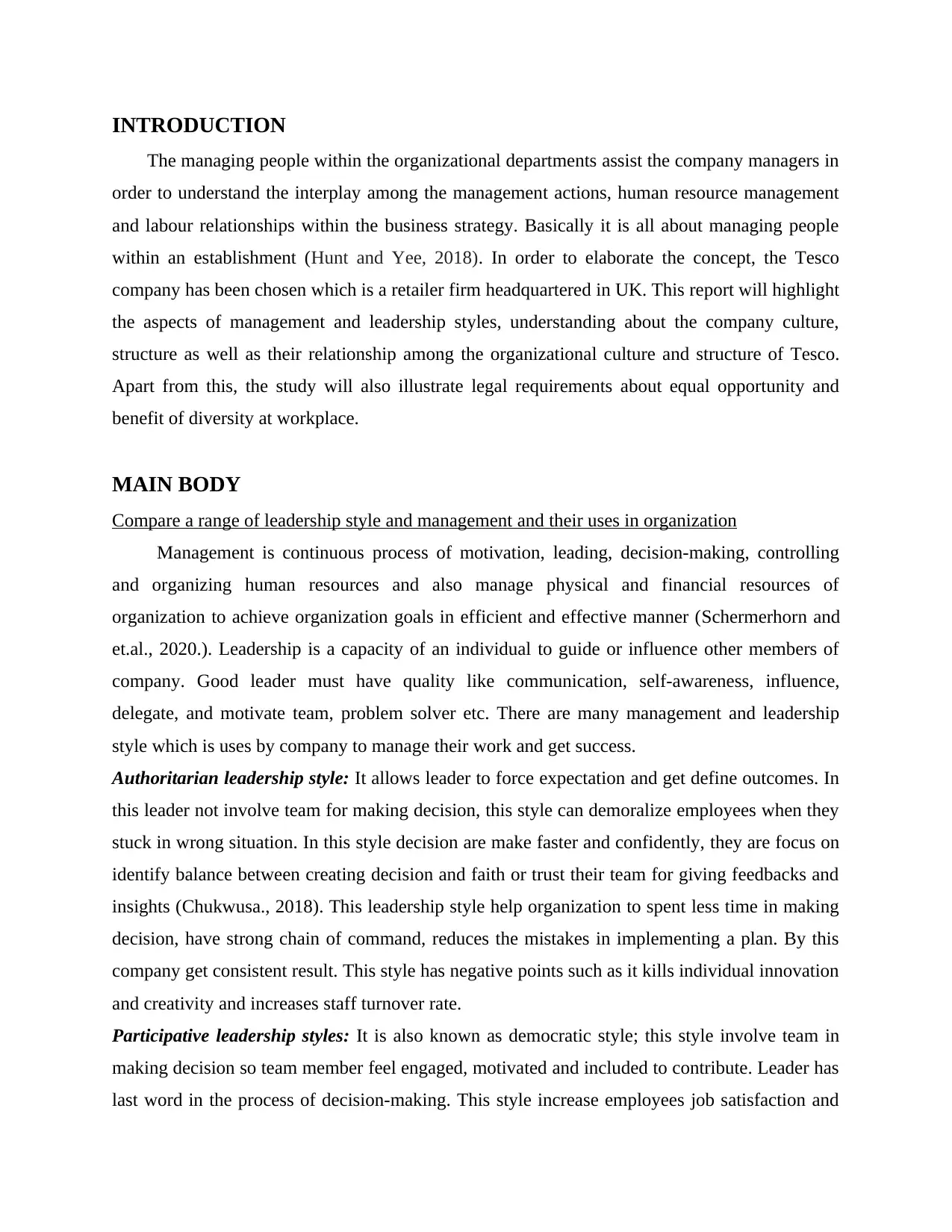
INTRODUCTION
The managing people within the organizational departments assist the company managers in
order to understand the interplay among the management actions, human resource management
and labour relationships within the business strategy. Basically it is all about managing people
within an establishment (Hunt and Yee, 2018). In order to elaborate the concept, the Tesco
company has been chosen which is a retailer firm headquartered in UK. This report will highlight
the aspects of management and leadership styles, understanding about the company culture,
structure as well as their relationship among the organizational culture and structure of Tesco.
Apart from this, the study will also illustrate legal requirements about equal opportunity and
benefit of diversity at workplace.
MAIN BODY
Compare a range of leadership style and management and their uses in organization
Management is continuous process of motivation, leading, decision-making, controlling
and organizing human resources and also manage physical and financial resources of
organization to achieve organization goals in efficient and effective manner (Schermerhorn and
et.al., 2020.). Leadership is a capacity of an individual to guide or influence other members of
company. Good leader must have quality like communication, self-awareness, influence,
delegate, and motivate team, problem solver etc. There are many management and leadership
style which is uses by company to manage their work and get success.
Authoritarian leadership style: It allows leader to force expectation and get define outcomes. In
this leader not involve team for making decision, this style can demoralize employees when they
stuck in wrong situation. In this style decision are make faster and confidently, they are focus on
identify balance between creating decision and faith or trust their team for giving feedbacks and
insights (Chukwusa., 2018). This leadership style help organization to spent less time in making
decision, have strong chain of command, reduces the mistakes in implementing a plan. By this
company get consistent result. This style has negative points such as it kills individual innovation
and creativity and increases staff turnover rate.
Participative leadership styles: It is also known as democratic style; this style involve team in
making decision so team member feel engaged, motivated and included to contribute. Leader has
last word in the process of decision-making. This style increase employees job satisfaction and
The managing people within the organizational departments assist the company managers in
order to understand the interplay among the management actions, human resource management
and labour relationships within the business strategy. Basically it is all about managing people
within an establishment (Hunt and Yee, 2018). In order to elaborate the concept, the Tesco
company has been chosen which is a retailer firm headquartered in UK. This report will highlight
the aspects of management and leadership styles, understanding about the company culture,
structure as well as their relationship among the organizational culture and structure of Tesco.
Apart from this, the study will also illustrate legal requirements about equal opportunity and
benefit of diversity at workplace.
MAIN BODY
Compare a range of leadership style and management and their uses in organization
Management is continuous process of motivation, leading, decision-making, controlling
and organizing human resources and also manage physical and financial resources of
organization to achieve organization goals in efficient and effective manner (Schermerhorn and
et.al., 2020.). Leadership is a capacity of an individual to guide or influence other members of
company. Good leader must have quality like communication, self-awareness, influence,
delegate, and motivate team, problem solver etc. There are many management and leadership
style which is uses by company to manage their work and get success.
Authoritarian leadership style: It allows leader to force expectation and get define outcomes. In
this leader not involve team for making decision, this style can demoralize employees when they
stuck in wrong situation. In this style decision are make faster and confidently, they are focus on
identify balance between creating decision and faith or trust their team for giving feedbacks and
insights (Chukwusa., 2018). This leadership style help organization to spent less time in making
decision, have strong chain of command, reduces the mistakes in implementing a plan. By this
company get consistent result. This style has negative points such as it kills individual innovation
and creativity and increases staff turnover rate.
Participative leadership styles: It is also known as democratic style; this style involve team in
making decision so team member feel engaged, motivated and included to contribute. Leader has
last word in the process of decision-making. This style increase employees job satisfaction and
⊘ This is a preview!⊘
Do you want full access?
Subscribe today to unlock all pages.

Trusted by 1+ million students worldwide
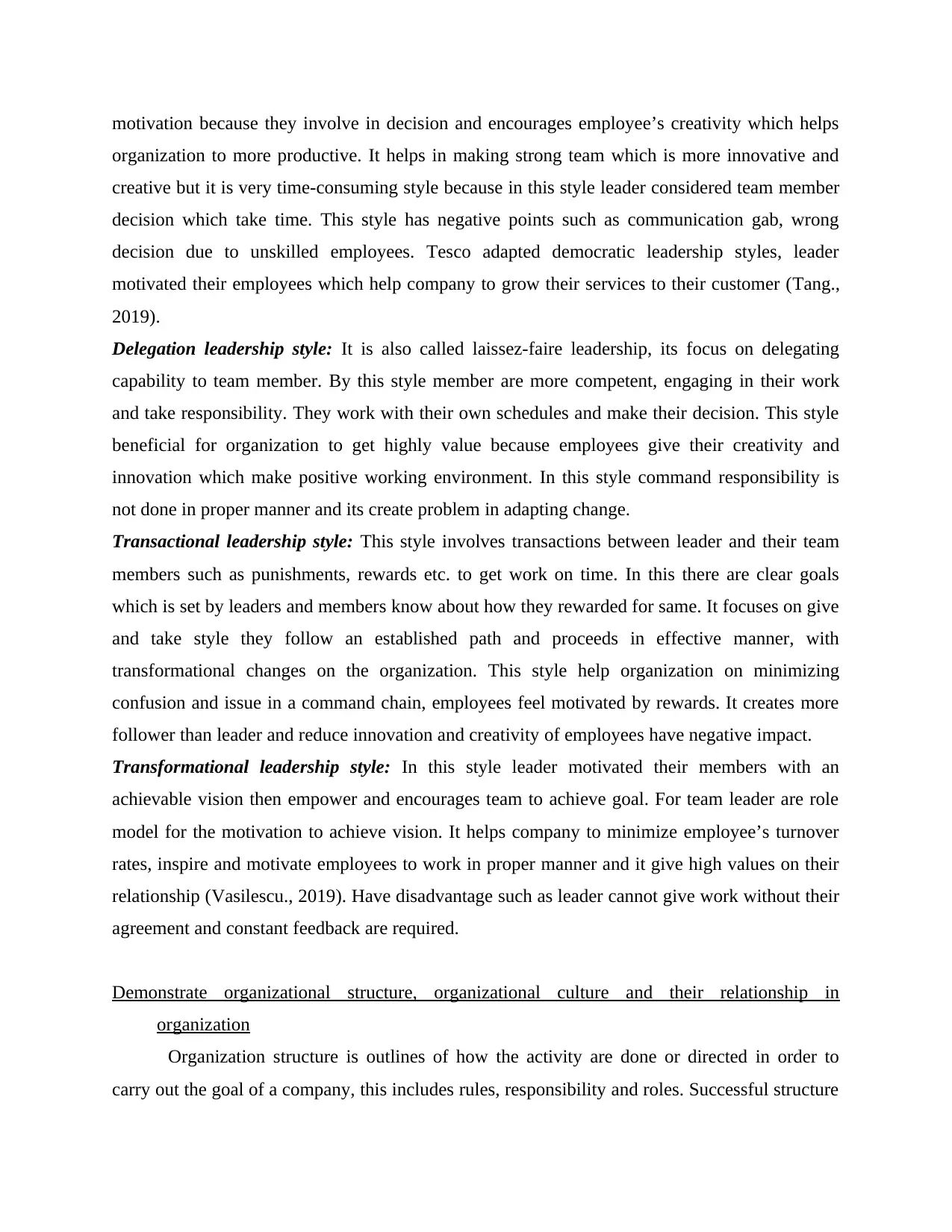
motivation because they involve in decision and encourages employee’s creativity which helps
organization to more productive. It helps in making strong team which is more innovative and
creative but it is very time-consuming style because in this style leader considered team member
decision which take time. This style has negative points such as communication gab, wrong
decision due to unskilled employees. Tesco adapted democratic leadership styles, leader
motivated their employees which help company to grow their services to their customer (Tang.,
2019).
Delegation leadership style: It is also called laissez-faire leadership, its focus on delegating
capability to team member. By this style member are more competent, engaging in their work
and take responsibility. They work with their own schedules and make their decision. This style
beneficial for organization to get highly value because employees give their creativity and
innovation which make positive working environment. In this style command responsibility is
not done in proper manner and its create problem in adapting change.
Transactional leadership style: This style involves transactions between leader and their team
members such as punishments, rewards etc. to get work on time. In this there are clear goals
which is set by leaders and members know about how they rewarded for same. It focuses on give
and take style they follow an established path and proceeds in effective manner, with
transformational changes on the organization. This style help organization on minimizing
confusion and issue in a command chain, employees feel motivated by rewards. It creates more
follower than leader and reduce innovation and creativity of employees have negative impact.
Transformational leadership style: In this style leader motivated their members with an
achievable vision then empower and encourages team to achieve goal. For team leader are role
model for the motivation to achieve vision. It helps company to minimize employee’s turnover
rates, inspire and motivate employees to work in proper manner and it give high values on their
relationship (Vasilescu., 2019). Have disadvantage such as leader cannot give work without their
agreement and constant feedback are required.
Demonstrate organizational structure, organizational culture and their relationship in
organization
Organization structure is outlines of how the activity are done or directed in order to
carry out the goal of a company, this includes rules, responsibility and roles. Successful structure
organization to more productive. It helps in making strong team which is more innovative and
creative but it is very time-consuming style because in this style leader considered team member
decision which take time. This style has negative points such as communication gab, wrong
decision due to unskilled employees. Tesco adapted democratic leadership styles, leader
motivated their employees which help company to grow their services to their customer (Tang.,
2019).
Delegation leadership style: It is also called laissez-faire leadership, its focus on delegating
capability to team member. By this style member are more competent, engaging in their work
and take responsibility. They work with their own schedules and make their decision. This style
beneficial for organization to get highly value because employees give their creativity and
innovation which make positive working environment. In this style command responsibility is
not done in proper manner and its create problem in adapting change.
Transactional leadership style: This style involves transactions between leader and their team
members such as punishments, rewards etc. to get work on time. In this there are clear goals
which is set by leaders and members know about how they rewarded for same. It focuses on give
and take style they follow an established path and proceeds in effective manner, with
transformational changes on the organization. This style help organization on minimizing
confusion and issue in a command chain, employees feel motivated by rewards. It creates more
follower than leader and reduce innovation and creativity of employees have negative impact.
Transformational leadership style: In this style leader motivated their members with an
achievable vision then empower and encourages team to achieve goal. For team leader are role
model for the motivation to achieve vision. It helps company to minimize employee’s turnover
rates, inspire and motivate employees to work in proper manner and it give high values on their
relationship (Vasilescu., 2019). Have disadvantage such as leader cannot give work without their
agreement and constant feedback are required.
Demonstrate organizational structure, organizational culture and their relationship in
organization
Organization structure is outlines of how the activity are done or directed in order to
carry out the goal of a company, this includes rules, responsibility and roles. Successful structure
Paraphrase This Document
Need a fresh take? Get an instant paraphrase of this document with our AI Paraphraser
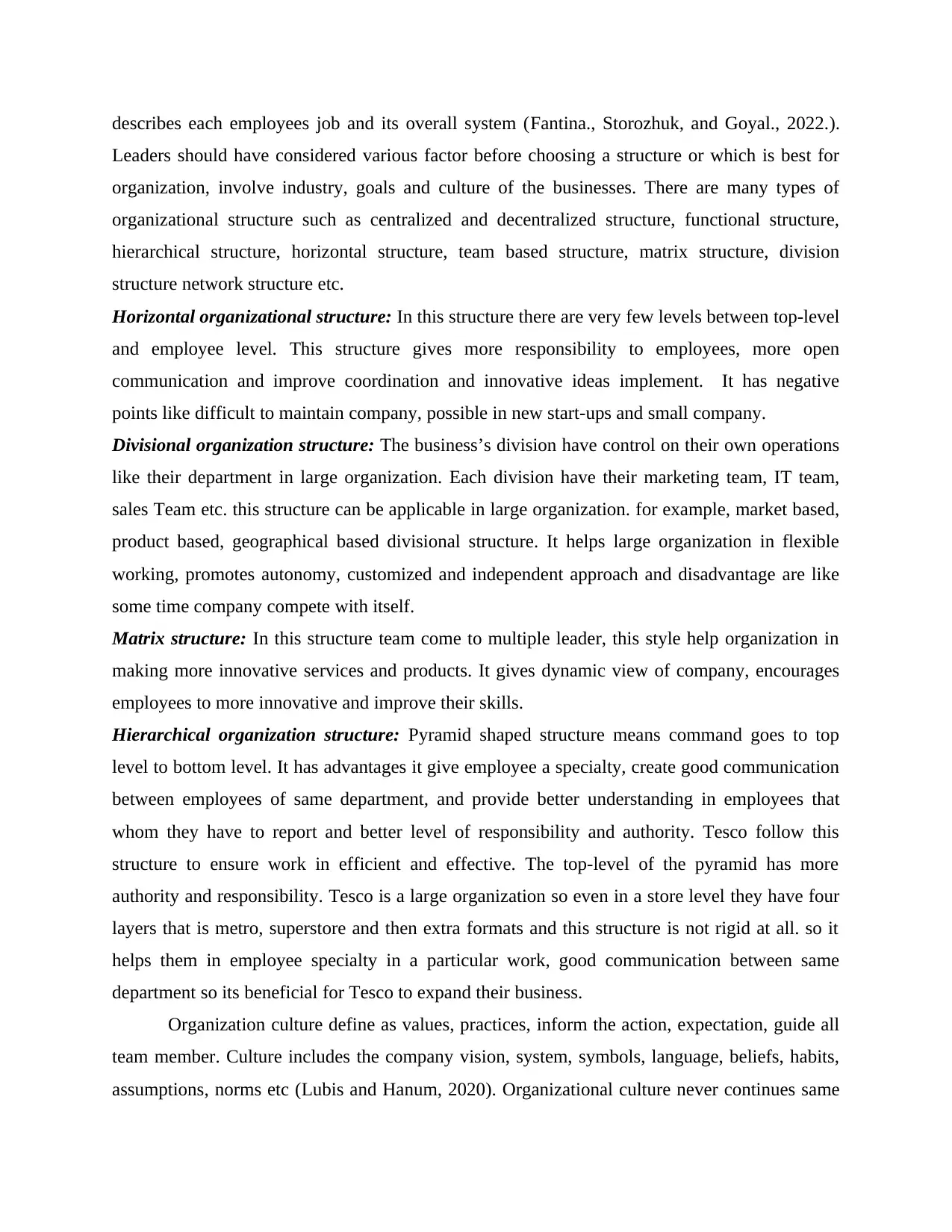
describes each employees job and its overall system (Fantina., Storozhuk, and Goyal., 2022.).
Leaders should have considered various factor before choosing a structure or which is best for
organization, involve industry, goals and culture of the businesses. There are many types of
organizational structure such as centralized and decentralized structure, functional structure,
hierarchical structure, horizontal structure, team based structure, matrix structure, division
structure network structure etc.
Horizontal organizational structure: In this structure there are very few levels between top-level
and employee level. This structure gives more responsibility to employees, more open
communication and improve coordination and innovative ideas implement. It has negative
points like difficult to maintain company, possible in new start-ups and small company.
Divisional organization structure: The business’s division have control on their own operations
like their department in large organization. Each division have their marketing team, IT team,
sales Team etc. this structure can be applicable in large organization. for example, market based,
product based, geographical based divisional structure. It helps large organization in flexible
working, promotes autonomy, customized and independent approach and disadvantage are like
some time company compete with itself.
Matrix structure: In this structure team come to multiple leader, this style help organization in
making more innovative services and products. It gives dynamic view of company, encourages
employees to more innovative and improve their skills.
Hierarchical organization structure: Pyramid shaped structure means command goes to top
level to bottom level. It has advantages it give employee a specialty, create good communication
between employees of same department, and provide better understanding in employees that
whom they have to report and better level of responsibility and authority. Tesco follow this
structure to ensure work in efficient and effective. The top-level of the pyramid has more
authority and responsibility. Tesco is a large organization so even in a store level they have four
layers that is metro, superstore and then extra formats and this structure is not rigid at all. so it
helps them in employee specialty in a particular work, good communication between same
department so its beneficial for Tesco to expand their business.
Organization culture define as values, practices, inform the action, expectation, guide all
team member. Culture includes the company vision, system, symbols, language, beliefs, habits,
assumptions, norms etc (Lubis and Hanum, 2020). Organizational culture never continues same
Leaders should have considered various factor before choosing a structure or which is best for
organization, involve industry, goals and culture of the businesses. There are many types of
organizational structure such as centralized and decentralized structure, functional structure,
hierarchical structure, horizontal structure, team based structure, matrix structure, division
structure network structure etc.
Horizontal organizational structure: In this structure there are very few levels between top-level
and employee level. This structure gives more responsibility to employees, more open
communication and improve coordination and innovative ideas implement. It has negative
points like difficult to maintain company, possible in new start-ups and small company.
Divisional organization structure: The business’s division have control on their own operations
like their department in large organization. Each division have their marketing team, IT team,
sales Team etc. this structure can be applicable in large organization. for example, market based,
product based, geographical based divisional structure. It helps large organization in flexible
working, promotes autonomy, customized and independent approach and disadvantage are like
some time company compete with itself.
Matrix structure: In this structure team come to multiple leader, this style help organization in
making more innovative services and products. It gives dynamic view of company, encourages
employees to more innovative and improve their skills.
Hierarchical organization structure: Pyramid shaped structure means command goes to top
level to bottom level. It has advantages it give employee a specialty, create good communication
between employees of same department, and provide better understanding in employees that
whom they have to report and better level of responsibility and authority. Tesco follow this
structure to ensure work in efficient and effective. The top-level of the pyramid has more
authority and responsibility. Tesco is a large organization so even in a store level they have four
layers that is metro, superstore and then extra formats and this structure is not rigid at all. so it
helps them in employee specialty in a particular work, good communication between same
department so its beneficial for Tesco to expand their business.
Organization culture define as values, practices, inform the action, expectation, guide all
team member. Culture includes the company vision, system, symbols, language, beliefs, habits,
assumptions, norms etc (Lubis and Hanum, 2020). Organizational culture never continues same
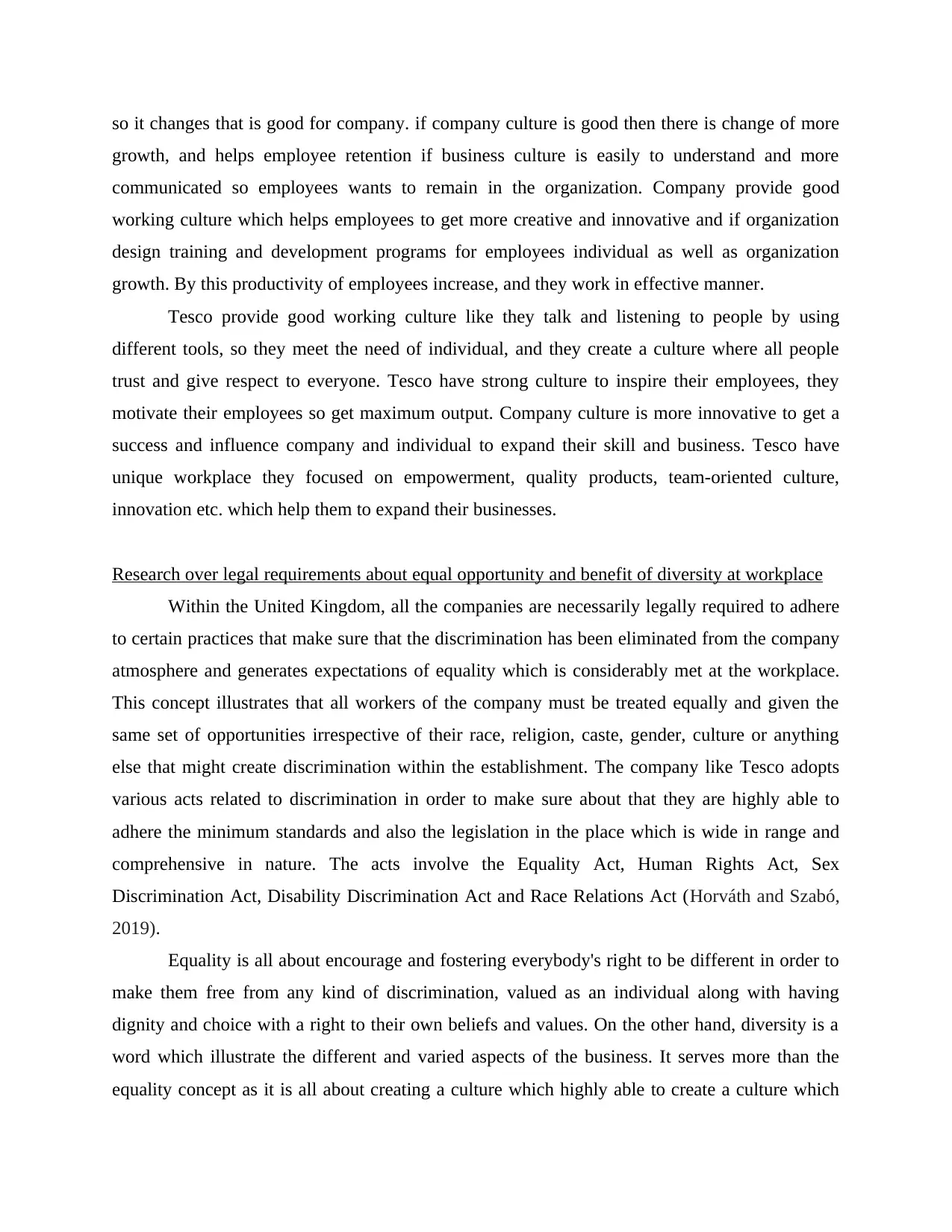
so it changes that is good for company. if company culture is good then there is change of more
growth, and helps employee retention if business culture is easily to understand and more
communicated so employees wants to remain in the organization. Company provide good
working culture which helps employees to get more creative and innovative and if organization
design training and development programs for employees individual as well as organization
growth. By this productivity of employees increase, and they work in effective manner.
Tesco provide good working culture like they talk and listening to people by using
different tools, so they meet the need of individual, and they create a culture where all people
trust and give respect to everyone. Tesco have strong culture to inspire their employees, they
motivate their employees so get maximum output. Company culture is more innovative to get a
success and influence company and individual to expand their skill and business. Tesco have
unique workplace they focused on empowerment, quality products, team-oriented culture,
innovation etc. which help them to expand their businesses.
Research over legal requirements about equal opportunity and benefit of diversity at workplace
Within the United Kingdom, all the companies are necessarily legally required to adhere
to certain practices that make sure that the discrimination has been eliminated from the company
atmosphere and generates expectations of equality which is considerably met at the workplace.
This concept illustrates that all workers of the company must be treated equally and given the
same set of opportunities irrespective of their race, religion, caste, gender, culture or anything
else that might create discrimination within the establishment. The company like Tesco adopts
various acts related to discrimination in order to make sure about that they are highly able to
adhere the minimum standards and also the legislation in the place which is wide in range and
comprehensive in nature. The acts involve the Equality Act, Human Rights Act, Sex
Discrimination Act, Disability Discrimination Act and Race Relations Act (Horváth and Szabó,
2019).
Equality is all about encourage and fostering everybody's right to be different in order to
make them free from any kind of discrimination, valued as an individual along with having
dignity and choice with a right to their own beliefs and values. On the other hand, diversity is a
word which illustrate the different and varied aspects of the business. It serves more than the
equality concept as it is all about creating a culture which highly able to create a culture which
growth, and helps employee retention if business culture is easily to understand and more
communicated so employees wants to remain in the organization. Company provide good
working culture which helps employees to get more creative and innovative and if organization
design training and development programs for employees individual as well as organization
growth. By this productivity of employees increase, and they work in effective manner.
Tesco provide good working culture like they talk and listening to people by using
different tools, so they meet the need of individual, and they create a culture where all people
trust and give respect to everyone. Tesco have strong culture to inspire their employees, they
motivate their employees so get maximum output. Company culture is more innovative to get a
success and influence company and individual to expand their skill and business. Tesco have
unique workplace they focused on empowerment, quality products, team-oriented culture,
innovation etc. which help them to expand their businesses.
Research over legal requirements about equal opportunity and benefit of diversity at workplace
Within the United Kingdom, all the companies are necessarily legally required to adhere
to certain practices that make sure that the discrimination has been eliminated from the company
atmosphere and generates expectations of equality which is considerably met at the workplace.
This concept illustrates that all workers of the company must be treated equally and given the
same set of opportunities irrespective of their race, religion, caste, gender, culture or anything
else that might create discrimination within the establishment. The company like Tesco adopts
various acts related to discrimination in order to make sure about that they are highly able to
adhere the minimum standards and also the legislation in the place which is wide in range and
comprehensive in nature. The acts involve the Equality Act, Human Rights Act, Sex
Discrimination Act, Disability Discrimination Act and Race Relations Act (Horváth and Szabó,
2019).
Equality is all about encourage and fostering everybody's right to be different in order to
make them free from any kind of discrimination, valued as an individual along with having
dignity and choice with a right to their own beliefs and values. On the other hand, diversity is a
word which illustrate the different and varied aspects of the business. It serves more than the
equality concept as it is all about creating a culture which highly able to create a culture which
⊘ This is a preview!⊘
Do you want full access?
Subscribe today to unlock all pages.

Trusted by 1+ million students worldwide
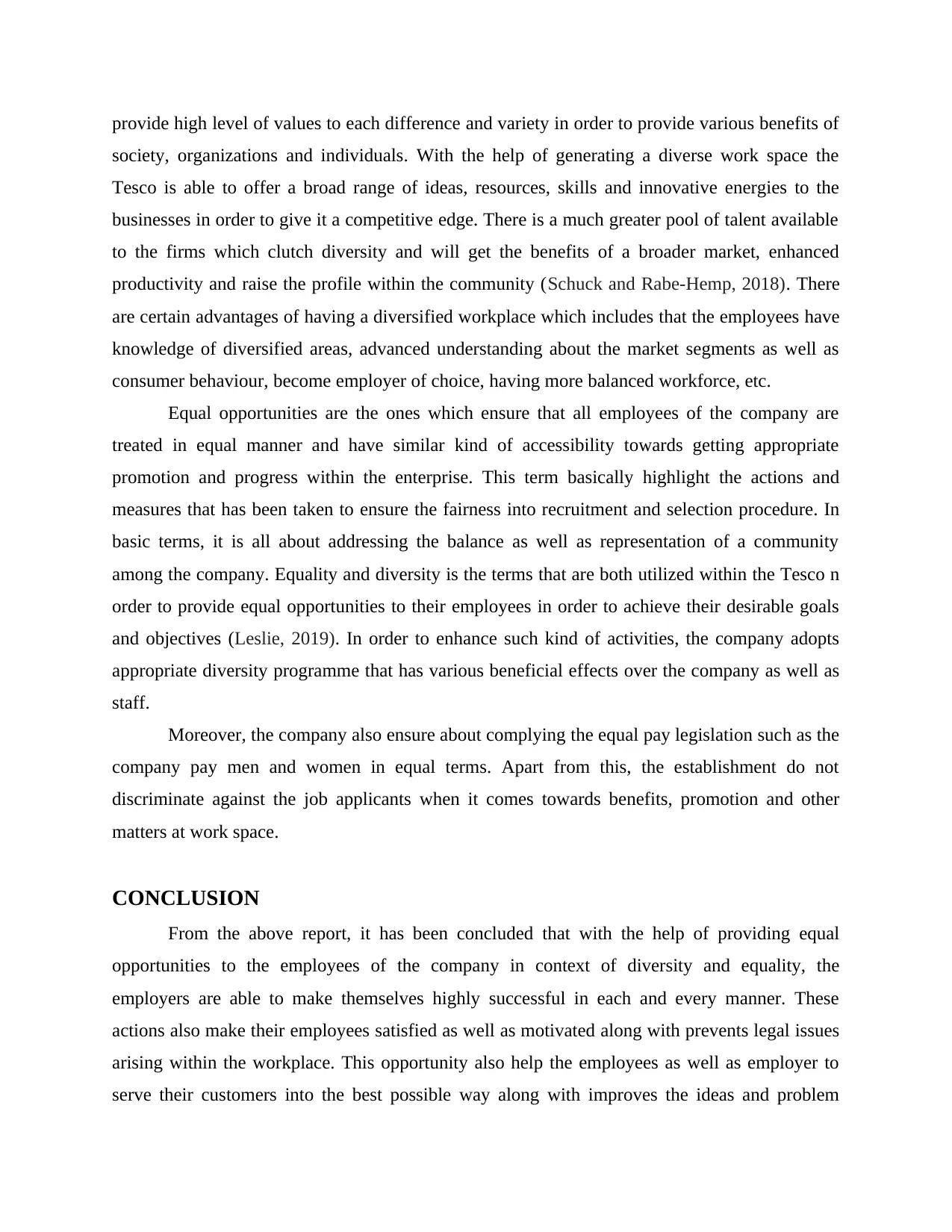
provide high level of values to each difference and variety in order to provide various benefits of
society, organizations and individuals. With the help of generating a diverse work space the
Tesco is able to offer a broad range of ideas, resources, skills and innovative energies to the
businesses in order to give it a competitive edge. There is a much greater pool of talent available
to the firms which clutch diversity and will get the benefits of a broader market, enhanced
productivity and raise the profile within the community (Schuck and Rabe-Hemp, 2018). There
are certain advantages of having a diversified workplace which includes that the employees have
knowledge of diversified areas, advanced understanding about the market segments as well as
consumer behaviour, become employer of choice, having more balanced workforce, etc.
Equal opportunities are the ones which ensure that all employees of the company are
treated in equal manner and have similar kind of accessibility towards getting appropriate
promotion and progress within the enterprise. This term basically highlight the actions and
measures that has been taken to ensure the fairness into recruitment and selection procedure. In
basic terms, it is all about addressing the balance as well as representation of a community
among the company. Equality and diversity is the terms that are both utilized within the Tesco n
order to provide equal opportunities to their employees in order to achieve their desirable goals
and objectives (Leslie, 2019). In order to enhance such kind of activities, the company adopts
appropriate diversity programme that has various beneficial effects over the company as well as
staff.
Moreover, the company also ensure about complying the equal pay legislation such as the
company pay men and women in equal terms. Apart from this, the establishment do not
discriminate against the job applicants when it comes towards benefits, promotion and other
matters at work space.
CONCLUSION
From the above report, it has been concluded that with the help of providing equal
opportunities to the employees of the company in context of diversity and equality, the
employers are able to make themselves highly successful in each and every manner. These
actions also make their employees satisfied as well as motivated along with prevents legal issues
arising within the workplace. This opportunity also help the employees as well as employer to
serve their customers into the best possible way along with improves the ideas and problem
society, organizations and individuals. With the help of generating a diverse work space the
Tesco is able to offer a broad range of ideas, resources, skills and innovative energies to the
businesses in order to give it a competitive edge. There is a much greater pool of talent available
to the firms which clutch diversity and will get the benefits of a broader market, enhanced
productivity and raise the profile within the community (Schuck and Rabe-Hemp, 2018). There
are certain advantages of having a diversified workplace which includes that the employees have
knowledge of diversified areas, advanced understanding about the market segments as well as
consumer behaviour, become employer of choice, having more balanced workforce, etc.
Equal opportunities are the ones which ensure that all employees of the company are
treated in equal manner and have similar kind of accessibility towards getting appropriate
promotion and progress within the enterprise. This term basically highlight the actions and
measures that has been taken to ensure the fairness into recruitment and selection procedure. In
basic terms, it is all about addressing the balance as well as representation of a community
among the company. Equality and diversity is the terms that are both utilized within the Tesco n
order to provide equal opportunities to their employees in order to achieve their desirable goals
and objectives (Leslie, 2019). In order to enhance such kind of activities, the company adopts
appropriate diversity programme that has various beneficial effects over the company as well as
staff.
Moreover, the company also ensure about complying the equal pay legislation such as the
company pay men and women in equal terms. Apart from this, the establishment do not
discriminate against the job applicants when it comes towards benefits, promotion and other
matters at work space.
CONCLUSION
From the above report, it has been concluded that with the help of providing equal
opportunities to the employees of the company in context of diversity and equality, the
employers are able to make themselves highly successful in each and every manner. These
actions also make their employees satisfied as well as motivated along with prevents legal issues
arising within the workplace. This opportunity also help the employees as well as employer to
serve their customers into the best possible way along with improves the ideas and problem
Paraphrase This Document
Need a fresh take? Get an instant paraphrase of this document with our AI Paraphraser
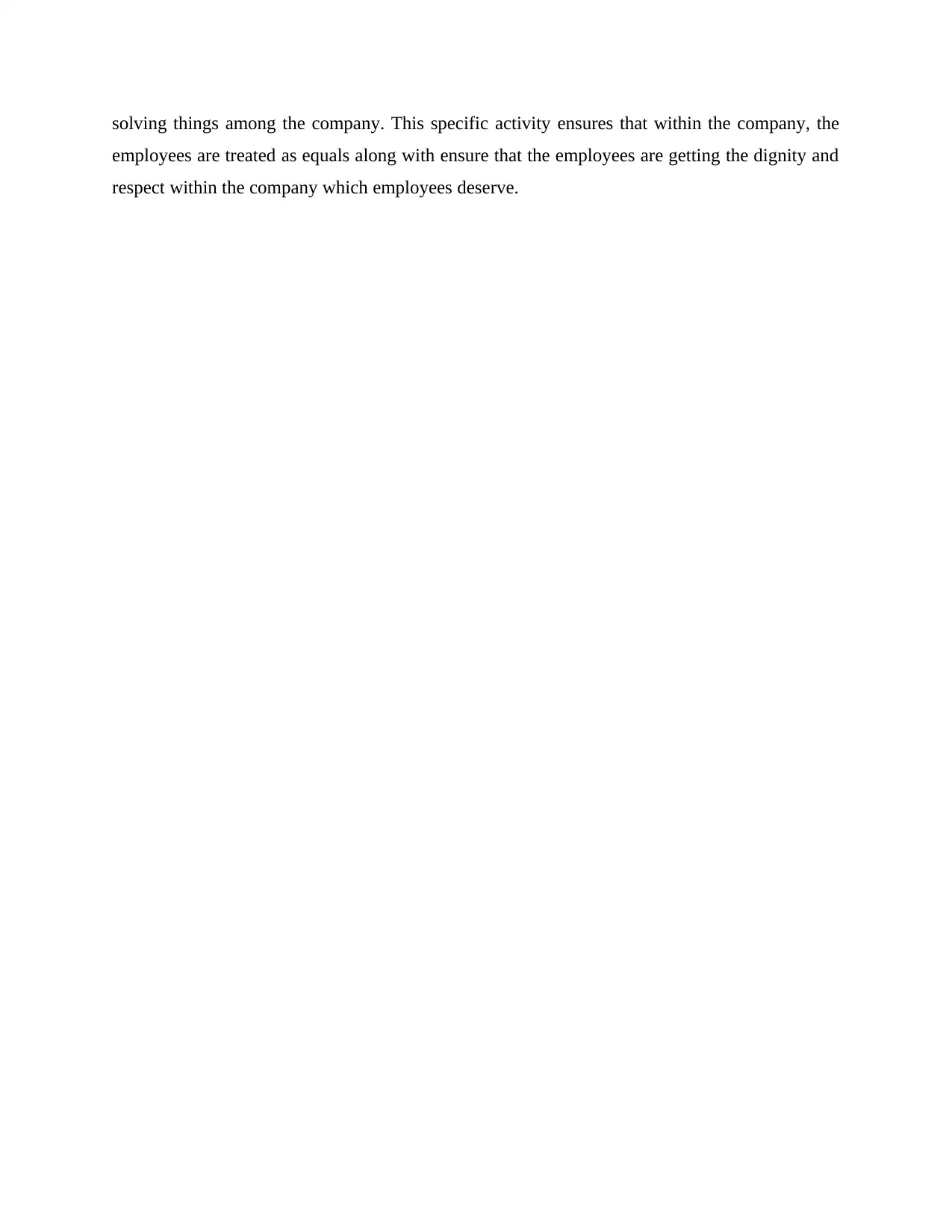
solving things among the company. This specific activity ensures that within the company, the
employees are treated as equals along with ensure that the employees are getting the dignity and
respect within the company which employees deserve.
employees are treated as equals along with ensure that the employees are getting the dignity and
respect within the company which employees deserve.
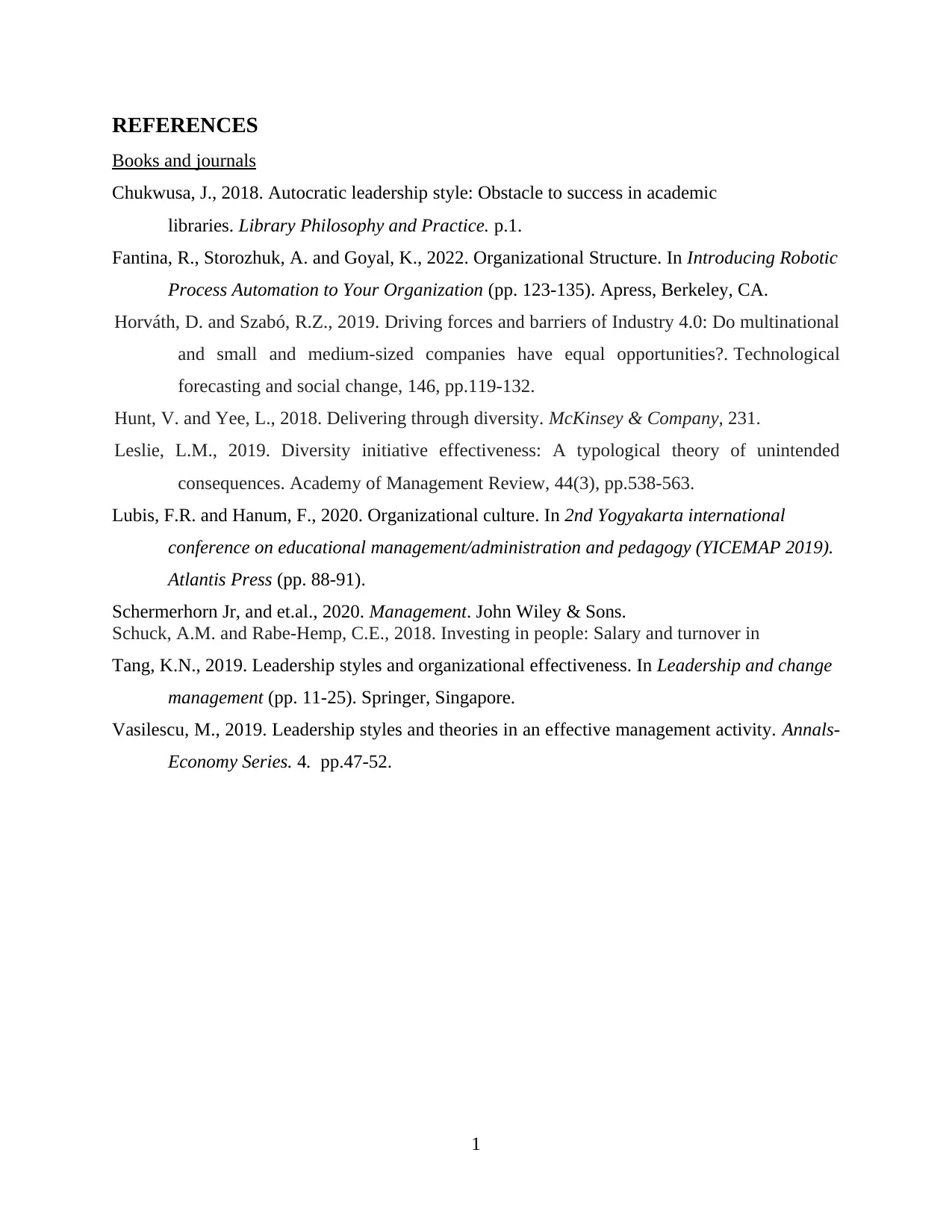
REFERENCES
Books and journals
Chukwusa, J., 2018. Autocratic leadership style: Obstacle to success in academic
libraries. Library Philosophy and Practice. p.1.
Fantina, R., Storozhuk, A. and Goyal, K., 2022. Organizational Structure. In Introducing Robotic
Process Automation to Your Organization (pp. 123-135). Apress, Berkeley, CA.
Horváth, D. and Szabó, R.Z., 2019. Driving forces and barriers of Industry 4.0: Do multinational
and small and medium-sized companies have equal opportunities?. Technological
forecasting and social change, 146, pp.119-132.
Hunt, V. and Yee, L., 2018. Delivering through diversity. McKinsey & Company, 231.
Leslie, L.M., 2019. Diversity initiative effectiveness: A typological theory of unintended
consequences. Academy of Management Review, 44(3), pp.538-563.
Lubis, F.R. and Hanum, F., 2020. Organizational culture. In 2nd Yogyakarta international
conference on educational management/administration and pedagogy (YICEMAP 2019).
Atlantis Press (pp. 88-91).
Schermerhorn Jr, and et.al., 2020. Management. John Wiley & Sons.
Schuck, A.M. and Rabe-Hemp, C.E., 2018. Investing in people: Salary and turnover in
Tang, K.N., 2019. Leadership styles and organizational effectiveness. In Leadership and change
management (pp. 11-25). Springer, Singapore.
Vasilescu, M., 2019. Leadership styles and theories in an effective management activity. Annals-
Economy Series. 4. pp.47-52.
1
Books and journals
Chukwusa, J., 2018. Autocratic leadership style: Obstacle to success in academic
libraries. Library Philosophy and Practice. p.1.
Fantina, R., Storozhuk, A. and Goyal, K., 2022. Organizational Structure. In Introducing Robotic
Process Automation to Your Organization (pp. 123-135). Apress, Berkeley, CA.
Horváth, D. and Szabó, R.Z., 2019. Driving forces and barriers of Industry 4.0: Do multinational
and small and medium-sized companies have equal opportunities?. Technological
forecasting and social change, 146, pp.119-132.
Hunt, V. and Yee, L., 2018. Delivering through diversity. McKinsey & Company, 231.
Leslie, L.M., 2019. Diversity initiative effectiveness: A typological theory of unintended
consequences. Academy of Management Review, 44(3), pp.538-563.
Lubis, F.R. and Hanum, F., 2020. Organizational culture. In 2nd Yogyakarta international
conference on educational management/administration and pedagogy (YICEMAP 2019).
Atlantis Press (pp. 88-91).
Schermerhorn Jr, and et.al., 2020. Management. John Wiley & Sons.
Schuck, A.M. and Rabe-Hemp, C.E., 2018. Investing in people: Salary and turnover in
Tang, K.N., 2019. Leadership styles and organizational effectiveness. In Leadership and change
management (pp. 11-25). Springer, Singapore.
Vasilescu, M., 2019. Leadership styles and theories in an effective management activity. Annals-
Economy Series. 4. pp.47-52.
1
⊘ This is a preview!⊘
Do you want full access?
Subscribe today to unlock all pages.

Trusted by 1+ million students worldwide

2
1 out of 10
Related Documents
Your All-in-One AI-Powered Toolkit for Academic Success.
+13062052269
info@desklib.com
Available 24*7 on WhatsApp / Email
![[object Object]](/_next/static/media/star-bottom.7253800d.svg)
Unlock your academic potential
Copyright © 2020–2025 A2Z Services. All Rights Reserved. Developed and managed by ZUCOL.




